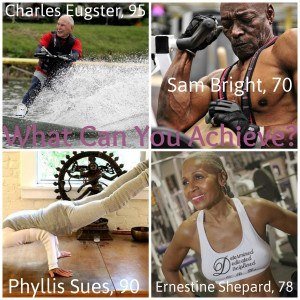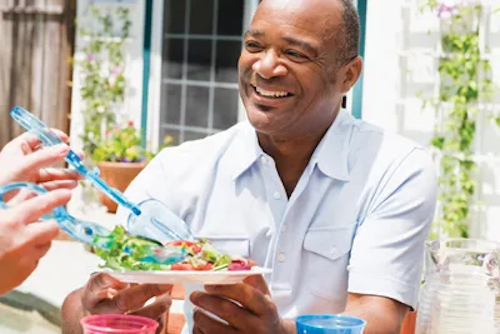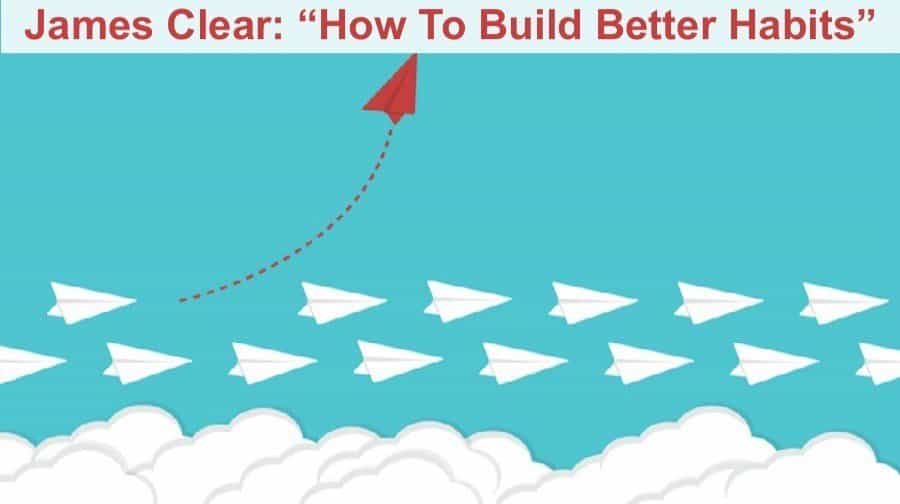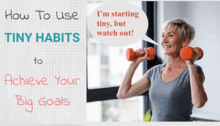Youthful Aging: The Right Mindset and Smart Choices

Youthful aging is not only possible, it’s probable if you adopt the right mindset to do the right things. Learn how to build a longevity mindset by making certain, smart choices.
“Youthful aging” is a ubiquitous term, but is it an oxymoron; meaning, can you really be both young and old?
Nope, not to me. I think youthful aging means keeping or developing the mindset prevalent in those chronologically younger to you, which then sets you up to maintain or develop the lifestyle behaviors common to them.
This post is about how to youthfully age. You begin by nurturing the right mindset, and then armed with this dominant attitude, you act to make specific lifestyle behaviors habitual, one by one.
Journalists Holly Burns and Tara Parker-Pope inspired this post. I’ll summarize what they wrote in their articles, respectively, How to Change Your Mind-Set About Aging and How To Age Well, and will add my own perspectives and resources on the topic of youthful aging.
Let’s dig in…
Youthful Aging Begins with the Right Mindset
We begin with journalist Holly Burns’ recounting the epitome of youthful aging, Johnnie Cooper. To celebrate her 90th birthday, Ms. Cooper climbed up the ladder to a diving board and gracefully executed a perfect dive into a pool where she then engaged in a vigorous game of Marco Polo.
Who does that at 90?
Someone who has prepared for it both mentally and physically. Someone devoted to youthful aging.
Holly Burns writes that Johnnie Cooper’s enthusiasm for growing older was palpable, undoubtedly a sentiment that contributed to her long, fulfilling life. While aging experiences vary widely, experts increasingly recognize the profound impact of one’s mindset on the aging process.
As I wrote in Four Masters Who Defy Age and Prove That You Can Too!, Ms. Cooper’s is the same  mindset that led:
mindset that led:
- Sam (“Sonny”) Bright Jr., 70, to become a bodybuilder after his divorce;
- Ernestine Shepard, 78, to become the world’s oldest female competitive bodybuilder in the world (and she didn’t start lifting weights till she was 56);
- Phyllis Sues, 90, to begin her own fashion label at 50, became a musician and learn Italian and French in her 70s, take tango and trapeze at 80, and begin yoga at 85; and
- Charles Eugster, 98, to obliterate the 95-and-over world indoor record for 200 meters at a British Masters Athletics meet in London in 2015.
Numerous studies have demonstrated that maintaining a positive outlook on aging is closely associated with better overall health and longevity; for instance:
- A study of 14,000 adults over age 50, co-authored by experts at Harvard T.H. Chan School of Public Health, found that the people who had the highest satisfaction with aging had a 43% lower risk of dying from any cause over a four-year period compared with those who were the least satisfied. The study also found that people more satisfied with the aging process had lower risk for conditions such as diabetes, stroke, cancer, and heart disease; better cognitive functioning [1].
- A study published in JAMA Open Network suggests that positive thinking about aging may help people better recover from mild cognitive impairment than those who don’t have as sunny an outlook. People with positive views on aging may also just have better health habits [2].
- A decades-long study involving 660 participants, conducted in 2002, revealed that individuals with positive beliefs about aging lived an average of seven and a half years longer than those with negative perceptions [3].
Not only do people with positive perceptions of aging live 7.5 years longer than those who don’t, but they also experience much higher rates of recovery from illness and injury, have better brain performance and improved memory, have a greater sense of control over their lives and a greater will to live, are more likely to talk to a doctor about health problems, get preventive care such as blood pressure screenings and flu shots, and pursue health promotion programs.
As the saying goes:
Attitude is everything.
- I’m getting old, every time you can’t find your keys, or forget someone’s name?
- I‘m too old to start a new career?
- I’m too old to join an exercise class?
- I’m too old to find a new mate?
It’s in your best interest to stop doing that.
As I’ve said, research has linked a positive aging mindset to lower blood pressure, enhanced longevity, and a reduced risk of developing dementia. Furthermore, those with a more favorable view of aging tend to adopt preventive health measures, such as regular exercise, which can further extend their lifespan.
While we can’t halt the march of time, we can certainly shape how we perceive it — and once that happens, we can work to slow down march; we can reduce our rate of aging.
Here are some strategies to help cultivate a youthful aging mindset:
Identify the source of age beliefs
Negative stereotypes of aging are pervasive, but it’s essential to recognize where these beliefs come from. Engage in “age belief journaling” for a week, documenting portrayals of older individuals in various media and conversations. Assess whether these portrayals were positive or negative and whether they could have been presented differently. This exercise helps distance yourself from negative ideas.
Challenge aging fears
Examine your worries about aging and assess how significant these concerns truly are. Avoid conflating age with disability, as many age-related issues have multifaceted causes. Understand that aging can bring resilience and personal growth.
Seek aging role models
Expand your perspective by seeking out role models who demonstrate that aging can be vibrant and fulfilling. Your role model doesn’t need to be an extreme example, like a 90-year-old diving enthusiast — it could be someone who regularly attends yoga classes or volunteers for a cause you admire. Create a list of five older individuals who have qualities or achievements you appreciate.
Embrace realistic optimism
Embrace a realistic form of optimism that acknowledges life’s challenges while maintaining a positive outlook. Instead of denying real concerns, acknowledge them and focus on adapting and finding solutions. Recognize that aging is a natural part of life, and with it comes a wealth of experience and wisdom.
Continue to learn
Learning new skills keeps the brain active, fires new connections, and provides a sense of purpose to achieve something never done before. Whether it’s juggling, ballroom dancing, learning a language, oil painting, crossword puzzles, or drafting a novel, the challenge can be stimulating mentally and physically.
Try new things
Doing something you’ve never done before can help you establish a new, empowering self-perspective, and also a different vision of the world around you. Visit somewhere you’ve always wanted to go. Go to the movies alone. Travel by train instead of car. Go ice-skating. Join a book club. Look at your bucket list or create one for ideas. Changing our day-to-day lives with a jolt of something different is a refreshing way to keep our minds active.
Reduce anxiety
Anxiety becomes more common with age, so adopt practices to help manage it. Become mindful about what thoughts make you anxious. Daily meditation, reading stoicism (philosophy that teaches how to maximize positive emotions and reduce negative ones), and simply spending some quiet time each day expressing gratitude are good places to begin. Practicing gratitude can help shift your focus from negative to positive thoughts. Take time each day to reflect on the things for which you’re grateful.
Emphasize the benefits
Aging brings not only physical changes but also emotional growth. Studies show that emotional well-being generally improves with age, and certain cognitive aspects, like conflict resolution, often get better. As you age, you’re likely to develop greater resilience, seeing yourself as a person with valuable lived experiences and wisdom.
Cultivating a positive mindset about aging can significantly impact your overall well-being and may lead to a longer, more fulfilling life. And to ensure that happens, ensure your youthful aging by making smart choices about your physical health.
Slow Down Aging with Smart Choices
Aging is an inevitable part of life, but the rate at which we age can be influenced by the choices we make along the way. From our dietary habits and exercise routines to our social interactions and life goals, the following health choices can play a vital, positive role in youthful aging by making your body stronger, healthier and more resilient.
Nourish your body
Small dietary changes can have a substantial impact on your aging process. Here are some guidelines:
- Maintain a Healthy Weight: Losing just 5% of your body weight can reduce the risk of diabetes and heart disease, improving metabolic function. Here are my posts about weight loss.
- Limit Processed Meats: Processed meats like hot dogs and sausages are linked to heart disease and diabetes. Opt for unprocessed alternatives. Read Red and processed meat consumption and risk of incident coronary heart disease, stroke, and diabetes: A systematic review and meta-analysis.
- Embrace Colorful Foods: Darkly colored fruits and vegetables, such as blueberries, cherries, spinach, and kale, are rich in nutrients and antioxidants. They promote health and reduce the temptation to indulge in junk food. Here are my posts about diet and nutrition.
- Avoid Processed Foods: Eliminate processed foods and beverages from your diet. This move reduces added sugars and leads to a healthier, whole-food-based diet. Read How Ultraprocessed Foods Can Hurt Your Brain and Gut.
Move your body
Regular exercise is crucial for healthy aging. Consider these tips:
- High-Intensity Interval Training: High-intensity interval training (HIIT) involves brief, intense bursts of exercise followed by recovery periods. It can provide significant health benefits, even with shorter workouts. Here are my HIIT posts.
- Strength Training: Engage in weightlifting exercises to maintain muscle mass and bone strength. You don’t need to lift heavy weights; consistency and effort are key. Here are my posts about building muscle.
- Balance Training: Improve balance to reduce the risk of falls, a common cause of injury in older adults. Read Physically Imbalanced? Start with Your Core.
- Exercise for Younger Skin: Exercise can improve the health and appearance of your skin by promoting thicker dermis layers and delaying visible signs of aging. Here are my posts about getting healthy skin.
Cultivate social connections
Maintaining relationships and forming new ones are crucial for healthy aging:
- Strengthen Social Ties: Stay connected with family, friends, and your community. Social interaction is associated with better health and longevity.
- Keep Working or Find Purposeful Activities: Continuing to work or engaging in meaningful activities can help maintain social connections and provide a sense of purpose.
Aging well is a combination of making smart choices in various aspects of life. While aging is inevitable, these choices can slow down the aging process, promote health, and contribute to a fulfilling, vibrant life. Remember, it’s never too late to start making positive changes to support healthy aging.
Of course, reading all this may be interesting, but reading alone won’t move the ball up the field. Youthful aging doesn’t happen by reading about youthful aging. To do that, you have to put what you just read into practice. It has to become habitual.
For that to happen, I suggest you read my posts on habit making, particularly these two:
James Clear: “How To Build Better Habits”
We all want to achieve things. We want more of some things, less of others. We also want to be better at a lot of things. To achieve something worthwhile typically requires focused attention applied to doing something habitually. Read this article and watch habit making expert James Clear show you how to build better habits.
New Tiny Habits: The Longevity Mindset, Part 3
Doing new tiny habits is the secret to building big habits that can change your life. If you want to slow down aging, reduce your biological age and live long and strong — you have no choice other than to learn a new way of living. And for that, you need to make new habits.
That’s it folks. Now get going — grab whatever is the lowest hanging fruit that you read about in this post and start jogging up the field to the youthful aging goal post!
Last Updated on February 7, 2024 by Joe Garma







